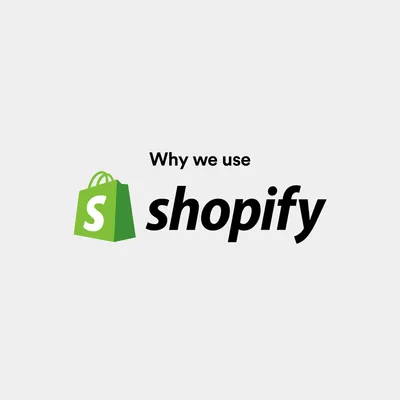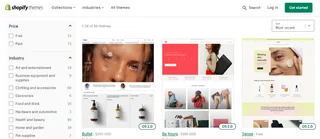Why We Use Shopify


At MadeByShape, no two projects are the same. We never know what to expect when a new enquiry drops into our inbox. We’ve worked with global brands but we’ve also worked with budding entrepreneurs just down the road to help them get their feet off the ground.
We don’t have a ‘type’ in the conventional sense, we don’t choose our projects based on sector or size. Our type is a business that shares the same values we do. So, we want to make sure we meet the needs of all our customers, and that means giving them the right eCommerce platform to grow their business on.
For businesses that need a no-fuss, out of the box, intuitive online shop, Shopify ticks a lot of boxes. This article will take a look at when and why the web developers at MadeByShape use Shopify, and what we consider when advising our clients.
For clients, budget is one of the major factors that hold sway over any project. Sometimes we’ll be working with a client of a limited budget. This could be their first professionally made website, or their first venture online. The budget is tight, we get it. In line with our values, we want to help all businesses grow, no matter what budget we’re working with.
Because Shopify comes at such an affordable price it allows us some wiggle room when it comes to the price point. Here we have a platform where you get a free SSL, no additional server costs, and your pick of themes and templates that can be tweaked and customised.
This means less time spent custom building the design from the ground up and more time focusing on the little things. Shopify’s modest pricing structure is as follows:
Basic: $29/month
Shopify: $79/month
Advanced: $299/month
For our developers, Shopify is very straightforward to use. This is good because it means we can breeze swiftly through elements of a project that would need more time and consideration if it was more bespoke such as a Craft Commerce website.
For example, Shopify is a fully hosted platform. This means we can get stuck into design elements to make your brand stand out, rather than files and coding, putting more of your budget where you want it to be.
In addition to the plethora of themes that can be adopted and customised, Shopify offers an extensive range of plugins via the Shopify App Store. If there isn’t a feature already built into your website, there will almost always be a Shopify plugin to provide exactly what you need. All of these features make Shopify a very straightforward platform for front-end development.

Shopify checkout
One aspect of building an online shop that can take up time and budget is creating a checkout. For businesses that sell online, having a robust, intuitive checkout system is one of the top priorities. It’s not something that can or should ever be glossed over.
Sometimes we’re required to build custom checkouts for businesses that work in certain ways, but using Shopify’s out-of-the-box checkout can be a great alternative that is quick and easy to install (it comes as standard on all Shopify websites).
Shopify’s checkout system is built to give businesses everything they need to convert customers and make sales. From adjustable shipping and tax fees to adding discount codes, Shopify’s checkout can be set up quickly. For clients, it’s also clear and easy to make minor adjustments in the CMS.
It’s not just setting up a checkout that can be done in a jiffy. Another major benefit of shopify is a quick turnaround on websites as a whole compared with Craft Commerce which requires a little more time and effort. While we love how much freedom we have when making a Craft Commerce website, for some clients, time is of the essence, and they’re after a simpler solution.
It can take as little as one week to put a Shopify website together. Along with its cost-effectiveness, this makes Shopify a superb option in situations like these:
Businesses working on a budget.
Businesses that need to convert over from a problematic or non-functioning website.
Businesses working towards a tight deadline such as a global event they want to be able to market at or during.
To get a better understanding of the process we take when creating a Shopify website, Tom explains it all in his article Starting a Shopify website with us - A step by step guide.

Shopify themes
In June 2021, Shopify announced the release of Online Store 2.0, a new selection of features and improvements that made themes easier to build and maintain—and more flexible to adapt.
We love Shopify’s new 2.0 themes and developer tools. The 2.0 update has improved content flexibility across Shopify websites and in turn, this gives us more freedom in both design and build.
Shopify’s selection of themes really helps to get the ball rolling if you’re not sure how you want your website to look. Here’s Mike’s rundown of some of the best-looking fashion eCommerce Shopify websites for inspiration.

Shopify apps
Apps or add-ons available through the Shopify app store allow our developers a broader range of functionality at a far more affordable cost than custom building these features. Shopify is known for its vast range of add-ons. In fact, it's one of the reasons many clients tell us they wish to switch to Shopify.
Many apps are built by Shopify itself, which is backed by excellent customer service if you ever have any issues with one. Third-party apps come with user ratings and extensive support information so you can be sure you know what you’re adding to the website. Tom gives a list of stand-out apps in his article A Look at Shopify and you can read our definitive list of the best Shopify Plugins too.
All in all, Shopify is a really important addition to our menu when we discuss our clients’ needs and goals. It’s definitely a platform we’d recommend for clients with a smaller scale or simpler online offering, as well as those who want something a bit more straightforward and budget-conscious.
But as I said, Shopify isn’t the only eCommerce platform in our arsenal. Take a look at Jason’s review of Shopify vs Craft Commerce, a more bespoke option. Craft Commerce is our preferred eCommerce platform and we are a Craft CMS verified partner. I also talk about Shopify compared with WooCommerce for those who want to know how the platforms stack up for WordPress.
Hello, I'm Natasia, and I'm a content writer for Shape.